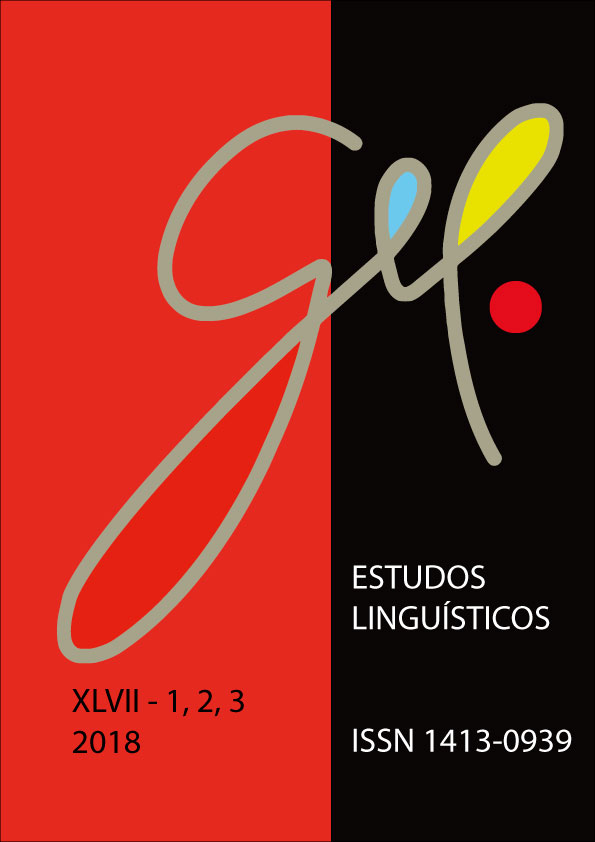Semantic variation and the notion of Functional-Conceptual Hierarchy
DOI:
https://doi.org/10.21165/el.v47i1.2011Keywords:
functional-conceptual hierarchy, semantic variation, prepositionsAbstract
Within Nanossintaxe, the variation in the syntactic-semantic behavior of distinct classes is explained by the fact that different languages would encode distinct parts of hierarchical functional sequences inside different lexical items. In turn, these sequences would be built from primitive concepts much finer grained than traditional syntactic categories and would approach a semantic-conceptual decomposition such as Jackendoff's (1983, 1990, 1997) proposal. For several authors (STARKE, 2010; CAHA, 2009; PANTECHVA, 2011), the question of variation would then be reduced to the difference in the size of the structures stored in different items of the lexicon. Therefore, this paper will present a discussion about the relevance of the application of the functional-conceptual hierarchy notion in the analysis of Brazilian Portuguese prepositions.Downloads
References
CAHA, P. Case movement in PPs. Nordlyd, v. 34, n. 2, p. 240-299, 2007.
CAHA, P. The case hierarchy as functional sequence. In: RICHARDS, M.; MALCHUKOV, A. L. (Eds.). Scales. LINGUISTISCHE ARBEITS BERICHTE 86, p. 247-276, Universität Leipzig. 2008. Disponível em: <http://www.uni-leipzig.de/~asw/lab/lab86/LAB86_Caha.pdf>. Acesso em: 10 jan. 2017.
CAHA, P. The nanosyntax of case. 2009. 334 f. Tese (Doutorado em Linguística) – University of Tromsø, Tromsø, 2009.
CAHA, P. Spell-out (Morphosyntax). Bruxelas, Bélgica, 7-11 abril 2014. Minicurso ministrado na First Glow Spring School (GSS1): ‘Theories in Dialogue’. Generative Linguistics in the Old World – GLOW 37.
CASTILHO, A. T. O problema da gramaticalização das preposições no Projeto Para a História do Português Brasileiro. Estudos linguísticos XXXIII, v. 33, p. 982-988, 2004. Disponível em: <http://www.gel.org.br/estudos-linguisticos/edicoes.php>. Acesso em: 10 jan. 2017.
ECKARDT, R. Meaning change in grammaticalization: an enquiry into semantic reanalysis. New York: Oxford University Press, 2006.
FÁBREGAS, A. An argument for phrasal spell-out: Indefinites and interrogatives in Spanish. Nordlyd, v. 36, n. 1, p. 129-168, 2009.
FÁBREGAS, A. The exhaustive lexicalisation principle. Nordlyd, v. 34, n. 2, p. 165-199, 2007.
FILLMORE, C. J. The case for case. In: BAHC, E.; HARMS, R. (Eds.). Proceedings of the Texas Symposium on Language Universals. April. 1967. p. 1-90. Disponível em: <https://eric.ed.gov/?id=ED019631>. Acesso em: 10 jan. 2017.
GRUBER, J. F. Studies in lexical relations. 1965. 305 f. Tese (Doutorado em Letras Modernas e Linguística) – Massachusetts Institute of Technology, Cambridge, 1965.
JACKENDOFF, R. Your theory of language evolution depends on your theory of language. In: LARSON, R. K.; DÉPREZ, V.; YAMAKIDO, H. (Eds). The evolution of human language: Biolinguistic perspectives. Cambridge: Cambridge University Press, 2010. p. 63-72. Disponível em: <http://ase.tufts.edu/cogstud/jackendoff/papers/languageevolution.pdf>. Acesso em: 10 jan. 2017.
JACKENDOFF, R. Foundations of Language. New York: Oxford University Press, 2002.
JACKENDOFF, R. Semantic Structures. v. 18. Cambridge: MIT Press, 1990.
JACKENDOFF, R. Semantics and Cognition. Cambridge: MIT Press, 1983.
JACKENDOFF, R. The architecture of the language faculty. Cambridge: MIT Press, 1997.
PANTCHEVA, M. B. The syntactic structure of locations, goals, and sources. Linguistics, 48, n. 5, p. 1043-1081. 2010.
PANTCHEVA, M. B. Decomposing Path: The Nanosyntax of Directional Expressions. 2011. 301 f. Tese (Doutorado em Linguística) – University of Tromsø, Tromsø, 2011.
PERLMUTTER, D. M. Impersonal passives and the unaccusative hypothesis. In: BLS 4: General Session. Annual meeting of the Berkeley Linguistics Society, v. 38, p. 157-189, 1978. Disponível em: <http://journals.linguisticsociety.org/proceedings/index.php/BLS/article/view/2198>. Acesso em: 10 jan. 2017.
RAMCHAND, G. Verb meaning and the lexicon: A first phase syntax. Cambridge: Cambridge University Press, 2008a.
RAMCHAND, G. Lexical items in complex predications: Selection as underassociation. Nordlyd, v. 35, n. 1, 2008b.
RAMCHAND, G. Minimalist semantics. In: BOECKX, C. (Ed.). The Oxford Handbook of Linguistic Minimalism. Oxford: Oxford University Press, 2011. p. 449-471.
RAMCHAND, G.; SVENONIUS, P. Deriving the functional hierarchy. Language Sciences, v. 46, p. 152-174, 2014.
SOARES, E. C.; MENUZZI, S. M. Introduzindo e problematizando papéis temáticos e hierarquias temáticas: uma questão de interfaces. Signo, v. 35, n. 59, p. 13-43, 2010.
SON, N.; SVENONIUS, P. Microparameters of cross-linguistic variation: Direct motion and resultatives. In: ABNER, N.; BISHOP, J. (Eds.). Proceedings of the 27th west coast conference on formal linguistics. Somerville, MA: Cascadilla Proceedings Project, 2010. 388-396. Disponível em: <https://pdfs.semanticscholar.org/07b6/c9b64242b8a94763a 9a40d739e838bad4e8f.pdf>. Acesso em 10 jan. 2017.
STARKE, M. Nanosyntax: a short primer to a new approach to language. Nordlyd, v. 36, n. 1, p. 1-16. 2010.
STARKE, M. On the inexistence of specifiers and the nature of heads. In: BELLETTI, A. (Ed.). Structures and Beyond: The Carthography of Syntactic Structures. Oxford: Oxford University Press Inc., 2004. p. 252-268.
STARKE, M. Towards an elegant solution to language variation: Variation reduces to the size of lexically stored trees. Não publicado. 2011. Disponível em: <http://ling.auf.net/lingbuzz/001183/current.pdf>. Acesso em: 10 jan. 2017.
SVENONIUS, P. Spatial P in English. In: CINQUE, Z.; RIZZI, L. (Eds.). Mapping spatial PPs: The cartography of syntactic structures, v. 6, p. 127-160, 2010.
SVENONIUS, P. The emergence of axial parts. In: SVENONIUS, P.; PANTCHEVA, M. (Eds.). Nordlyd, Tromsø Working Papers in Language & Linguistics: 33.1, Special Issue on Adpositions, p. 49-77. University of Tromsø, Tromsø, 2007. Disponível em: <http://www.ub.uit.no/baser/nordlyd/>. Acesso em: 10 jan. 2017.
TRAUGOTT, E. C.; DASHER, R. B. Regularity in semantic change. New York: Cambridge University Press, 2004.
ZWARTS, J. A hierarchy of locations: Evidence from the encoding of direction in adpositions and cases. Linguistics, v. 48, n. 5, p. 983-1009, 2010.
ZWARTS, J. Priorities in the production of prepositions. In: ASBURY, A.; DOTLACIL, J.; GEHRKE, B.; NOUWEN, R. (Eds.). Syntax and Semantics of Spatial P. Amsterdam: John Benjamins Publishing Co., 2008. p. 85-102.



